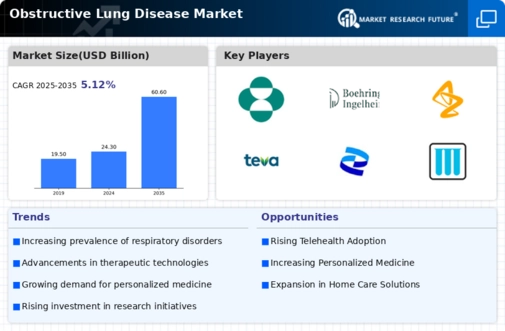Emerging Therapeutic Options
The emergence of novel therapeutic options is a significant driver of the Obstructive Lung Disease Market. Recent advancements in biologics and targeted therapies have opened new avenues for treatment, offering hope to patients with previously limited options. For example, monoclonal antibodies and small molecule inhibitors are being developed to address specific pathways involved in obstructive lung diseases. This diversification of treatment modalities is expected to enhance patient outcomes and satisfaction. As the market continues to evolve, the introduction of these innovative therapies is likely to attract investment and foster competition among pharmaceutical companies, ultimately benefiting patients.
Increased Awareness and Education
Growing awareness and education regarding obstructive lung diseases are pivotal in shaping the Obstructive Lung Disease Market. Public health campaigns and educational initiatives have been instrumental in informing individuals about the risks and symptoms associated with these conditions. This heightened awareness encourages early diagnosis and treatment, which is essential for effective disease management. Additionally, healthcare professionals are increasingly trained to recognize and address these diseases, further contributing to market growth. As more individuals seek medical advice and treatment, the demand for innovative therapies and management strategies is likely to rise, fostering a more robust market environment.
Government Initiatives and Funding
Government initiatives aimed at combating obstructive lung diseases are playing a crucial role in the Obstructive Lung Disease Market. Various health organizations and governmental bodies are allocating substantial funding for research, awareness campaigns, and the development of new treatment modalities. For instance, initiatives focused on smoking cessation and pollution control are directly linked to reducing the incidence of these diseases. Such efforts not only enhance public health but also stimulate investment in the pharmaceutical and biotechnology sectors, leading to the introduction of novel therapies. This supportive regulatory environment is likely to encourage innovation and growth within the market.
Advancements in Diagnostic Technologies
Technological advancements in diagnostic tools are significantly influencing the Obstructive Lung Disease Market. Enhanced imaging techniques, such as high-resolution computed tomography (HRCT) and advanced spirometry, allow for earlier and more accurate diagnosis of obstructive lung diseases. These innovations facilitate timely intervention, which is crucial for improving patient outcomes. Furthermore, the integration of artificial intelligence in diagnostic processes is emerging, potentially streamlining the identification of disease patterns. As diagnostic capabilities improve, healthcare providers are better equipped to manage and treat patients, thereby driving market growth and expanding the range of therapeutic options available.
Rising Prevalence of Obstructive Lung Diseases
The increasing incidence of obstructive lung diseases, such as chronic obstructive pulmonary disease (COPD) and asthma, is a primary driver of the Obstructive Lung Disease Market. According to recent estimates, millions of individuals are affected by these conditions, leading to a heightened demand for effective treatment options. The World Health Organization has indicated that COPD is projected to become the third leading cause of death by 2030, underscoring the urgency for innovative therapies. This rising prevalence not only amplifies the need for medical interventions but also stimulates research and development efforts within the industry, as stakeholders seek to address the growing burden of these diseases.

















Leave a Comment